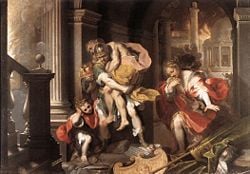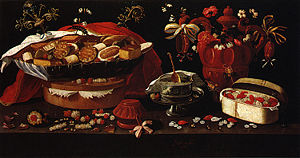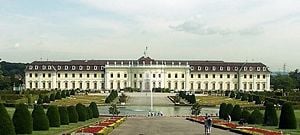Difference between revisions of "Baroque period" - New World Encyclopedia
Cheryl Lau (talk | contribs) (New page: thumb|right|250px|''Adoration,'' by [[Peter Paul Rubens. Dynamic figures spiral down around a void: draperies blow: a whirl of movement lit in a shaft of lig...) |
(Fixed and added references) |
||
| Line 144: | Line 144: | ||
*[http://www.haberarts.com/mytime.htm#baroque Essays on Baroque art] by John Haber | *[http://www.haberarts.com/mytime.htm#baroque Essays on Baroque art] by John Haber | ||
| − | == | + | ==References== |
| − | * | + | *Bazin, Germain, 1964. ''Baroque and Rococo'' New York and London: Thames & Hudson. ISBN 0500200181 |
| − | * | + | *Friedrich, Carl. J. 1952. ''The Rise of Modern Europe: The Age of the Baroque''. New York, Evanston, and London: Harper & Row. ASIN B000JVC1OS |
| − | * | + | *Wölfflin, Heinrich. 1964. ''Renaissance and Baroque'' Ithaca: Cornell University Press. ISBN 0801490464 |
| − | * | + | *Martin, John Rupert. 1977. ''Baroque''. New York, Hagerstown, San Francisco, London: Harper & Row. ISBN 0064300773 |
| + | *Sitwell, Sacheverell. 1967. ''Baroque and Rococo.'' New York: G.P. Putnam. ASIN B000NUJEW2 | ||
| + | *Tapie, Victor L. 1966. ''The Age of Grandeur.'' New York: Books That Matter. ASIN B000PROF04 | ||
{{Westernart}} | {{Westernart}} | ||
Revision as of 22:43, 21 June 2007
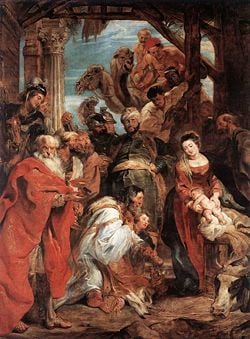
In the arts, Baroque is a period as well as the style that used exaggerated motion and clear, easily interpreted detail to produce drama, tension, exuberance, and grandeur in sculpture, painting, literature, dance, and music.[citation needed] The style started around 1600 in Rome, Italy and spread to most of Europe. In music, the Baroque applies to the final period of dominance of imitative counterpoint, where different voices and instruments echo each other but at different pitches, sometimes inverting the echo, and even reversing thematic material.[citation needed]
The popularity and success of the "Baroque" was encouraged by the Roman Catholic Church which had decided at the time of the Council of Trent that the arts should communicate religious themes in direct and emotional involvement. The aristocracy also saw the dramatic style of Baroque architecture and art as a means of impressing visitors and expressing triumphant power and control. Baroque palaces are built around an entrance sequence of courts, anterooms, grand staircases, and reception rooms of sequentially increasing magnificence. In similar profusions of detail, art, music, architecture, and literature inspired each other in the "Baroque" cultural movement as artists explored what they could create from repeated and varied patterns.
The word baroque derives probably from the ancient Portuguese noun "barroco" which is a pearl that is not round but of unpredictable and elaborate shape. Hence, in informal usage, the word baroque can simply mean that something is "elaborate", with many details, without reference to the Baroque styles of the seventeenth and eighteenth centuries.
A contrast with the classical
Classical compositions, according to characterizations first elaborated by Heinrich Wölfflin, seek the unchanging truth behind appearances, expressed with simplicity and clarity: each constituent element is complete in itself.
Evolution of the Baroque
Beginning around the year 1600, the demands for new art resulted in what is now known as the Baroque. The canon promulgated at the Council of Trent (1545–63), by which the Roman Catholic Church addressed the representational arts by demanding that paintings and sculptures in church contexts should speak to the illiterate rather than to the well-informed, is customarily offered as an inspiration of the Baroque, which appeared, however, a generation later. This turn toward a populist conception of the function of ecclesiastical art is seen by many art historians as driving the innovations of Caravaggio and the Carracci brothers, all of whom were working in Rome at that time.
The appeal of Baroque style turned consciously from the witty, intellectual qualities of 16th century Mannerist art to a visceral appeal aimed at the senses. It employed an iconography that was direct, simple, obvious, and dramatic. Baroque art drew on certain broad and heroic tendencies in Annibale Carracci and his circle, and found inspiration in other artists such as Correggio, Caravaggio, and Federico Barocci nowadays sometimes termed 'proto-Baroque'.
Germinal ideas of the Baroque can also be found in the work of Michelangelo.
Some general parallels in music make the expression "Baroque music" useful. Contrasting phrase lengths, harmony and counterpoint ousted polyphony, and orchestral color made a stronger appearance. (See Baroque music.) Similar fascination with simple, strong, dramatic expression in poetry, where clear, broad syncopated rhythms replaced the enknotted elaborated metaphysical similes employed by Mannerists such as John Donne and imagery that was strongly influenced by visual developments in painting, can be sensed in John Milton's Paradise Lost, a Baroque epic.
Though Baroque was superseded in many centers by the Rococo style, beginning in France in the late 1720s, especially for interiors, paintings and the decorative arts, Baroque architecture remained a viable style until the advent of Neoclassicism in the later 18th century. See the Neapolitan palace of Caserta, a Baroque palace (though in a chaste exterior) that was not even begun until 1752. Critics have given up talking about a "Baroque period."
In paintings, Baroque gestures are broader than Mannerist gestures: less ambiguous, less arcane and mysterious, more like the stage gestures of opera, a major Baroque artform. Baroque poses depend on contrapposto ("counterpoise"), the tension within the figures that moves the planes of shoulders and hips in counterdirections. It made the sculptures almost seem like they were about to move. See Bernini's David (below, left).
The dryer, chastened, less dramatic and coloristic, later stages of 18th century Baroque architectural style are often seen as a separate Late Baroque manifestation. (See Claude Perrault.) Academic characteristics in the neo-Palladian architectural style, epitomized by William Kent, are a parallel development in Britain and the British colonies: within doors, Kent's furniture designs are vividly influenced by the Baroque furniture of Rome and Genoa, hieratic tectonic sculptural elements meant never to be moved from their positions completing the wall elevation. Baroque is a style of unity imposed upon rich and massy detail.
The Baroque was defined by Heinrich Wölfflin as the age where the oval replaced the circle as the center of composition, centralization replaced balance, and coloristic and "painterly" effects began to become more prominent. Art historians, often Protestant ones, have traditionally emphasized that the Baroque style evolved during a time in which the Roman Catholic Church had to react against the many revolutionary cultural movements that produced a new science and new forms of religion—the Reformation. It has been said that the monumental Baroque is a style that could give the Papacy, like secular absolute monarchies, a formal, imposing way of expression that could restore its prestige, at the point of becoming somehow symbolic of the Catholic Reformation. Whether this is the case or not, it was successfully developed in Rome, where Baroque architecture widely renewed the central areas with perhaps the most important urbanistic revision during this period of time.
Baroque visual art
A defining statement of what Baroque signifies in painting is provided by the series of paintings executed by Peter Paul Rubens for Marie de Medici at the Luxembourg Palace in Paris (now at the Louvre) [1], in which a Catholic painter satisfied a Catholic patron: Baroque-era conceptions of monarchy, iconography, handling of paint, and compositions as well as the depiction of space and movement.
There were highly diverse strands of Italian baroque painting, from Caravaggio to Cortona; both approaching emotive dynamism with different styles. Another frequently cited work of Baroque art is Bernini's Saint Theresa in Ecstasy for the Cornaro chapel in Saint Maria della Vittoria, which brings together architecture, sculpture, and theater into one grand conceit [2].
The later Baroque style gradually gave way to a more decorative Rococo, which, through contrast, further defines Baroque.
The intensity and immediacy of baroque art and its individualism and detail—observed in such things as the convincing rendering of cloth and skin textures—make it one of the most compelling periods of Western art.
Baroque sculpture
In Baroque sculpture, groups of figures assumed new importance, and there was a dynamic movement and energy of human forms— they spiralled around an empty central vortex, or reached outwards into the surrounding space. For the first time, Baroque sculpture often had multiple ideal viewing angles. The characteristic Baroque sculpture added extra-sculptural elements, for example, concealed lighting, or water fountains. Aleijadinho in Brazil was also one of the great names of baroque sculpture, and his master work is the set of statues of the Santuário de Bom Jesus de Matosinhos in Congonhas. The soapstone sculptures of old testament prophets around the terrace are considered amongst his finest work.
The architecture, sculpture and fountains of Bernini (1598–1680) give highly charged characteristics of Baroque style. Bernini was undoubtedly the most important sculptor of the Baroque period. He approached Michelangelo in his omnicompetence: Bernini sculpted, worked as an architect, painted, wrote plays, and staged spectacles. In the late 20th century Bernini was most valued for his sculpture, both for his virtuosity in carving marble and his ability to create figures that combine the physical and the spiritual. He was also a fine sculptor of bust portraits in high demand among the powerful.
Bernini's Cornaro chapel: the complete work of art
A good example of Bernini's work that helps us understand the Baroque is his St. Theresa in Ecstasy (1645–52), created for the Cornaro Chapel of the church of Santa Maria della Vittoria, Rome. Bernini designed the entire chapel, a subsidiary space along the side of the church, for the Cornaro family.
He had, in essence, a brick box shaped something like a proscenium stage space with which to work. Saint Theresa, the focal point of the chapel, is a monochromatic marble statue (a soft white) surrounded by a polychromatic marble architectural framing concealing a window to light the statue from above. In shallow relief, sculpted figure-groups of the Cornaro family inhabit in opera boxes along the two side walls of the chapel. The setting places the viewer as a spectator in front of the statue with the Cornaro family leaning out of their box seats and craning forward to see the mystical ecstasy of the saint. St. Theresa is highly idealized in detail and in an imaginary setting. St. Theresa of Avila, a popular saint of the Catholic Reformation, wrote narratives of her mystical experiences aimed at the nuns of her Carmelite Order; these writings had become popular reading among lay people interested in pursuing spirituality. She once described the love of God as piercing her heart like a burning arrow. Bernini literalizes this image by placing St. Theresa on a cloud in a reclining pose; what can only be described as a Cupid figure holds a golden arrow (the arrow is made of metal) and smiles down at her. The angelic figure is not preparing to plunge the arrow into her heart— rather, he has withdrawn it. St. Theresa's face reflects not the anticipation of ecstasy, but her current fulfillment, which has been described as orgasmic.
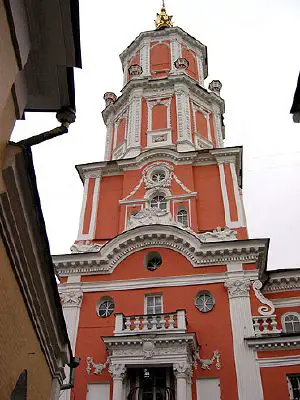
The blending of religious and erotic was intensely offensive to both neoclassical restraint and, later, to Victorian prudishness; it is part of the genius of the Baroque. Bernini, who in life and writing was a devout Catholic, is not attempting to satirize the experience of a chaste nun, but to embody in marble a complex truth about religious experience— that it is an experience that takes place in the body. Theresa described her bodily reaction to spiritual enlightenment in a language of ecstasy used by many mystics, and Bernini's depiction is earnest.
The Cornaro family promotes itself discreetly in this chapel; they are represented visually, but are placed on the sides of the chapel, witnessing the event from balconies. As in an opera house, the Cornaro have a privileged position in respect to the viewer, in their private reserve, closer to the saint; the viewer, however, has a better view from the front. They attach their name to the chapel, but St. Theresa is the focus. It is a private chapel in the sense that no one could say mass on the altar beneath the statue (in 17th century and probably through the 19th) without permission from the family, but the only thing that divides the viewer from the image is the altar rail. The spectacle functions both as a demonstration of mysticism and as a piece of family pride.
Baroque architecture
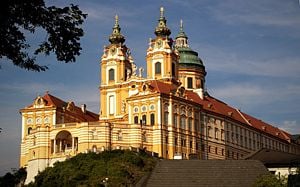
In Baroque architecture, new emphasis was placed on bold massing, colonnades, domes, light-and-shade (chiaroscuro), 'painterly' color effects, and the bold play of volume and void. In interiors, Baroque movement around and through a void informed monumental staircases that had no parallel in previous architecture. The other Baroque innovation in worldly interiors was the state apartment, a processional sequence of increasingly rich interiors that culminated in a presence chamber or throne room or a state bedroom. The sequence of monumental stairs followed by a state apartment was copied in smaller scale everywhere in aristocratic dwellings of any pretensions.
Baroque architecture was taken up with enthusiasm in central Germany (see e.g. Ludwigsburg Palace and Zwinger Dresden), Austria and Russia (see e.g. Peterhof and Catherine Palace). In England the culmination of Baroque architecture was embodied in work by Sir Christopher Wren, Sir John Vanbrugh and Nicholas Hawksmoor, from ca. 1660 to ca. 1725. Many examples of Baroque architecture and town planning are found in other European towns, and in Latin America. Town planning of this period featured radiating avenues intersecting in squares, which took cues from Baroque garden plans.In Sicily, Baroque developed new shapes and themes as in Noto and Acireale "Basilica di San Sebastiano"
Baroque theater and dance
In theater, the elaborate conceits, multiplicity of plot turns, and variety of situations characteristic of Mannerism (Shakespeare's tragedies, for instance) are superseded by opera, which drew together all the arts in a unified whole.
Theater evolves in the Baroque era and becomes a multimedia experience, starting with the actual architectural space. It is during this era that most of the technologies that we currently see in current Broadway or commercial plays were invented and developed. The stage changes from a romantic garden to the interior of a palace in a matter of seconds. The entire space becomes a framed selected area that only allows the users to see a specific action, hiding all the machinery and technology - mostly ropes and pulleys.
This technology affects the content of the narrated or performed pieces, practicing at its best the Deus ex Machina solution. Gods were finally able to come down - literally - from the heavens and rescue the hero in the most extreme and dangerous, even absurd situations.
The term Theatrum Mundi - the world is a stage - was also created. The social and political realm in the real world is manipulated in exactly the same way the actor and the machines are presenting/limiting what is being presented on stage, hiding selectiveley all the machinery that makes the actions happen. There is a wonderful German documentary called Theatrum Mundi that clearly portrays the political extents of the Baroque and its main representative, Louis XIV.
Watch movies like Vatel, Farinelli, and the wonderful staging of Monteverdi's Orpheus at the Gran Teatre del Liceu in Barcelona to see some wonderful recreations of this time period. William Christie, American, and Les Arts Florissants have performed an extensive research on all the French Baroque Opera, performing pieces from Charpentier and Lully, among others that are extemelly faithful to the original 17th century creations.
Dance was popular in the Baroque era.
Baroque literature and philosophy
Baroque actually expressed new values, which often are summarized in the use of metaphor and allegory, widely found in Baroque literature, and in the research for the "maraviglia" (wonder, astonishment — as in Marinism), the use of artifices. If Mannerism was a first breach with Renaissance, Baroque was an opposed language.[citation needed] The psychological pain of Man — a theme disbanded after the Copernican and the Lutheran revolutions in search of solid anchors, a proof of an "ultimate human power" — was to be found in both the art and architecture of the Baroque period. A relevant part of works was made on religious themes, since the Roman Church was the main "customer."[citation needed]
Virtuosity was researched by artists (and the virtuoso became a common figure in any art) together with realism and care for details (some talk of a typical "intricacy").
The privilege given to external forms had to compensate and balance the lack of content that has been observed in many Baroque works: Marino's "Maraviglia", for example, is practically made of the pure, mere form. Fantasy and imagination should be evoked in the spectator, in the reader, in the listener. All was focused around the individual Man, as a straight relationship between the artist, or directly the art and its user, its client. Art is then less distant from user, more directly approaching him, solving the cultural gap that used to keep art and user reciprocally far, by Maraviglia. But the increased attention to the individual, also created in these schemes some important genres like the Romanzo (novel) and let popular or local forms of art, especially dialectal literature, to be put into evidence. In Italy this movement toward the single individual (that some define a "cultural descent", while others indicate it was a possible cause for the classical opposition to Baroque) caused Latin to be definitely replaced by Italian.
In Spain, the baroque writers are framed in the Siglo de Oro. Naturalism and sharp criticist points of view about Spanish society are common in the conceptista writers like Quevedo, while culterano authors emphasize the importance of form with complicated images and the use of hyperbaton. In Catalonia the baroque took hold as well in Catalan language, with representatives including poets and dramaturgs such as Francesc Fontanella and Francesc Vicenç Garcia as well as the unique emblem book Atheneo de Grandesa by Josep Romaguera. Spanish theater was extensively developed by authors like Lope de Vega and Calderón de la Barca. Overall, Cervantes is considered the most complete author of Spanish literature due to his main work, Don Quixote. In Colonial Spanish America two of the best-known baroque writers were Sor Juana and Bernardo de Balbuena.
In the Portuguese Empire the most famous baroque writer of the time was Father António Vieira, a Jesuit who lived in Brazil during the 18th century. Secondary writers are Gregório de Matos and Francisco Rodrigues Lobo.
In English literature, the metaphysical poets represent a closely related movement; their poetry likewise sought unusual metaphors, which they then examined in often extensive detail. Their verse also manifests a taste for paradox, and deliberately inventive and unusual turns of phrase.
For German Baroque literature, see German literature of the Baroque period.
Baroque music
The term Baroque is also used to designate the style of music composed during a period that overlaps with that of Baroque art, but usually encompasses a slightly later period. J.S. Bach and G.F. Handel are often considered its culminating figures.
It is a still-debated question as to what extent Baroque music shares aesthetic principles with the visual and literary arts of the Baroque period. A fairly clear, shared element is a love of ornamentation, and it is perhaps significant that the role of ornament was greatly diminished in both music and architecture as the Baroque gave way to the Classical period.
It should be noted that the application of the term "Baroque" to music is a relatively recent development. The first use of the word "Baroque" in music was only in 1919, by Curt Sachs, and it was not until 1940 that it was first used in English (in an article published by Manfred Bukofzer). Even as late as 1960 there was still considerable dispute in academic circles over whether music as diverse as that by Jacopo Peri, François Couperin and J.S. Bach could be meaningfully bundled together under a single stylistic term.
Many musical styles were born in that era, like the Concerto and symphonia. Styles like sonata, cantata and oratoria flourished. Also, Opera was born out of the experimentation of the Florentine Camerata, the creators of monody, who attempted to recreate the theatrical arts of the ancient Greeks. Indeed, it is exactly that development which is often used to denote the beginning of the musical Baroque, around 1600.
Examples of Baroque music
(In chronological order.)
- Claudio Monteverdi (1567–1643) Vespers (1610)
- Heinrich Schütz (1585–1672), Symphoniae Sacrae (1629, 1647, 1650)
- Johann Pachelbel (1653–1706), Canon in D (1680)
- Jean-Baptiste Lully (1632–1687) Armide (1686)
- Henry Purcell (1659–1695) Dido and Aeneas (1687)
- Antonio Vivaldi (1678–1741), L'Estro Armonico (1711) incl. The four seasons
- George Frideric Handel (1685–1759), Water Music Suite (1717)
- Domenico Scarlatti (1685–1757), Sonatas for Cembalo or Harpsichord
- Jean-Philippe Rameau (1683–1764) Dardanus (1739)
- Johann Sebastian Bach (1685–1750), The Art of Fugue (1749)
- Georg Philipp Telemann (1681–1767), Der Tag des Gerichts ("The Day of Judgement") (1762)
- Carlos Seixas (1704–1742), Harpsichord Concerto
The term "Baroque"
The word "Baroque", like most period or stylistic designations, was invented by later critics rather than practitioners of the arts in the 17th and early 18th centuries. It is a French translation of the Portuguese phrase "pérola barroca", which means "irregular pearl", or false jewel—notably, an ancient similar word, "Barlocco" or "Brillocco", is used in Roman dialect for the same meaning—and natural pearls that deviate from the usual, regular forms so they do not have an axis of rotation are known as "baroque pearls". The word may have been influenced by the mnemonic term "Baroco" denoting, in logical Scholastica, a supposedly laboured form of syllogism.
The term "Baroque" was initially used with a derogatory meaning, to underline the excesses of its emphasis, of its eccentric redundancy, its noisy abundance of details, as opposed to the clearer and sober rationality of the Renaissance. It was first rehabilitated by the Swiss-born art historian, Heinrich Wölfflin (1864–1945) in his Renaissance und Barock (1888); Wölfflin identified the Baroque as "movement imported into mass," an art antithetic to Renaissance art. He did not make the distinctions between Mannerism and Baroque that modern writers do, and he ignored the later phase, the academic Baroque that lasted into the 18th century. Writers in French and English did not begin to treat Baroque as a respectable study until Wölfflin's influence had made German scholarship pre-eminent.
Modern usage
In contemporary culture the term "baroque" is also commonly used to describe any artistic style that could be extremely elaborate, ornamented or adorned. In reality, the modern usage of baroque has nothing or very little to do with classic baroque, even though many people are unaware of the distinction.
See also
- Baroque architecture
- Baroque music
- Spanish Baroque
- Baroque chess
External links
- Dictionary of the History of Ideas: Baroque in literature
- The greatest works of Baroque literature
- Webmuseum Paris
- barocke in Val di Noto - Sizilien
- Baroque in the "History of Art"
- Essays on Baroque art by John Haber
ReferencesISBN links support NWE through referral fees
- Bazin, Germain, 1964. Baroque and Rococo New York and London: Thames & Hudson. ISBN 0500200181
- Friedrich, Carl. J. 1952. The Rise of Modern Europe: The Age of the Baroque. New York, Evanston, and London: Harper & Row. ASIN B000JVC1OS
- Wölfflin, Heinrich. 1964. Renaissance and Baroque Ithaca: Cornell University Press. ISBN 0801490464
- Martin, John Rupert. 1977. Baroque. New York, Hagerstown, San Francisco, London: Harper & Row. ISBN 0064300773
- Sitwell, Sacheverell. 1967. Baroque and Rococo. New York: G.P. Putnam. ASIN B000NUJEW2
- Tapie, Victor L. 1966. The Age of Grandeur. New York: Books That Matter. ASIN B000PROF04
| Western art movements |
| Renaissance · Mannerism · Baroque · Rococo · Neoclassicism · Romanticism · Realism · Pre-Raphaelite · Academic · Impressionism · Post-Impressionism |
| 20th century |
| Modernism · Cubism · Expressionism · Abstract expressionism · Abstract · Neue Künstlervereinigung München · Der Blaue Reiter · Die Brücke · Dada · Fauvism · Art Nouveau · Bauhaus · De Stijl · Art Deco · Pop art · Futurism · Suprematism · Surrealism · Minimalism · Post-Modernism · Conceptual art |
Credits
New World Encyclopedia writers and editors rewrote and completed the Wikipedia article in accordance with New World Encyclopedia standards. This article abides by terms of the Creative Commons CC-by-sa 3.0 License (CC-by-sa), which may be used and disseminated with proper attribution. Credit is due under the terms of this license that can reference both the New World Encyclopedia contributors and the selfless volunteer contributors of the Wikimedia Foundation. To cite this article click here for a list of acceptable citing formats.The history of earlier contributions by wikipedians is accessible to researchers here:
The history of this article since it was imported to New World Encyclopedia:
Note: Some restrictions may apply to use of individual images which are separately licensed.
